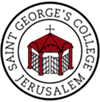St George’s College has experienced numerous serious disruptions to its ministry over the past fifty years and there is an institutional memory of surviving these great challenges. We are in another of those moments of deep rupture. Once again, it isn’t the result of the College’s mismanagement or errors of judgement. This crisis is brought about by an explosion of violence between Israelis and Palestinians which has resulted in atrocities by both sides causing devastating numbers of deaths and casualties. The College staff along with people of all faiths and none, mourn these tragic events and the grief and deep trauma which result.
Pilgrims and tourists have fled in their droves. There has been a rush to the airport even as there have been wholesale cancellation of flights. We have a group of 33 pilgrims with us on a study pilgrimage and it has been a profoundly challenging experience for them. Several decided to leave to return home. But 30 have remained, determined to do as much of their greatly anticipated experience that safety and sensible planning will allow. They feel confident in the College’s planning and assessment of direct risks and so, barring one day when we simply sheltered in the College library, we have been able to offer an adapted schedule of visits to key holy sites in Jerusalem and Galilee. This has been based on a realistic assessment of risks and not a stubborn resistance to accept the facts on the ground.
Rev Rodney Aist, Course Director, Rev Andrew Mayes, Chaplain and myself have been able to lead and guide the course with fortitude, in the best traditions of St George’s College, determined not to be daunted by events. The Palestinian staff have faced very serious challenges to get to work owing to closed checkpoints for some and unsafe travel circumstances for others. But we have managed to offer a good experience for our pilgrims. These travellers from the US, Canada and Australia have been extraordinarily determined, patient and flexible. We hope and pray that they will be able to return as planned in a few days’ time, but they all know there is a risk that they will have to remain longer than planned. We have however had to cancel the pilgrimage which follows this one which is a blow to all. Will it be possible that this is the only cancelled course? We just do not know. We will communicate with those registered on upcoming courses as and when necessary.
Far more serious than that are the realities on the ground for Palestinians and Israelis especially for all those living in Gaza and those living in the environs outside the Strip.
The implications for all the peoples of the Holy Land could not be more serious. Death, injury, grief, loss of homes and livelihoods is on a scale not seen in these lands since 1967. Everyone is shocked by the extreme violence which has broken out and of course, all killings of innocents and targeting of children and women must be condemned, but the trouble has been brewing for years. A system which subjects two million West Bank Palestinians to military occupation and also incarcerates two million Gazans in an open prison is unsustainable and will inevitably lead to extreme violence. Exactly what can be done to change this reality cannot be agreed upon yet but it is certain that change must come. This change must give Palestinians a viable and acceptable way to live their lives in freedom. Equally, the Israelis have the right to defend their borders and live with security. May the God of all hope lead us out of darkness into God’s kingdom of peace and justice. It feels a very long way off but we cling onto that hope and we must realise that small steps in the right direction give us momentum towards that distant target, which is our goal.







